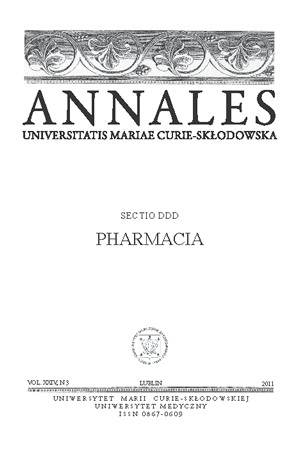Changes in the antioxidant activity of polyphenols purple basil leaves (Ocimum basilicum L. cv. Dark Opal) induced by selected abiotic elicitors
DOI:
https://doi.org/10.12923/Keywords:
purple basil, elicitors, phenolics, antioxidant activityAbstract
Purple basil (Ocimum basilicum L. cv. Dark Opal), cultivated in grown chamber, pretreated with abiotic elicitors: arachidonic acid (AA), jasmonic acid (JA) and b-aminobutyric acid (BABA). The content of: total phenolics, flavonoids, phenolic acids and anthocyanins in methanolic extracts of basil leaves were determined. Antioxidant activity of obtained extracts against DPPH• and ABTS•+ and Fe(II) chelating ability also were investigated. In extracts of basil pretreated with AA and JA increase of the content of all analyzed polyphenols was observed. The most effective inductor was jasmonic acid, which caused increase of phenolic acids content by 36%, flavonoids by 20% in comparison to control. The increase of antioxidant activity of analyzed extracts was detected – the best antiradical effects were obtained after arachidonic acid treatment. The b-aminobutyric acid was not effective elicitor to inducing polyhenols in basil.
References
1. Bahorun T et al.: Total phenol, flavonoid, proanthocyanidin and vitamin C levels and antioxidant activities of Mauritian vegetables. J Sci Food Agric, 84, 1553, 2004
2. Brand-Williams W, Cuvelier E, Berset CM: Use of free radical method to evaluate antioxidant activity. LWT, 28, 25, 1995.
3. Dzida K: Biological value and essential oil content in sweet basil (Ocimum basilicum L.) depending on calcium fertilization and cultivar. Acta Sci. Pol., Hortorum Cultus, 9(4), 153, 2010.
4. Giusti MM, Worlstad RE (2001): Unit F1.2: Characterization and measurement of anthocyanins by UV-visible spectroscopy. In: Current protocols in food analytical chemistry. New York: John Willey and Sons.
5. Guo J-T et al.: Antioxidant properties of the extracts from different parts of broccoli in Taiwan. J Food Drug Anal, 9(2), 96, 2001.
6. Hakkim FL, Shankar CG, Girija S: Chemical composition and antioxidant property of Holy Basil (Ocimum sanctum L.) leaves, stems, and inflorescence and their in vitro callus cultures. J. Agric. Food Chem, 55, 9109, 2007.
7. Horbowicz M et al.: The effect of methyl jasmonate and phenolic acids on growth of seedlings the effect of methyl jasmonate and phenolic acids on Growth of seedlings and accumulation of anthocyanins in common buckwheat (Fagopyrum esculentum Moench). Acta Agrobotanica, 62 (1), 49, 2009.
8. Horbowicz M et al: Anthocyanins of fruits and vegetables – their occurrence, analysis and role in human nutrition. Veget. Crops Res. Bull, 68, 5, 2008.
9. Javanmardi J et al.: Chemical characterization of basil (Ocimum basilicum L.) found in local accessions and used in traditional medicines in Iran. J. Agric. Food Chem., 50, 5878, 2002.
10. Jungmin L, Carolyn FS: Chicoric acid found in basil (Ocimum basilicum L.) leaves. Food Chem., 115, 650, 2009.
11. Kim H et al.: Effect of chitosan on the biological properties of sweet basil (Ocimum basillicum L.). J. Agric. Food Chem. 53, 3696, 2005.
12. Kim H et al.: Effect of methyl jasmonate on secondary metabolites of sweet basil (Ocimum basilicum L.). J. Agric. Food Chem., 54, 2327, 2006.
13. Kim H et al.: Effect of methyl jasmonate on phenolic compounds and carotenoids of romaine lettuce (Lactuca sativa L.). J. Agric. Food Chem., 55, 10366, 2007.
14. Re R et al.: Antioxidant activity applying an improved ABTS radical cation decolorisation assay. Free Rad Biol Med, 26, 1231, 1999.
15. Saniewski M, Horbowicz M, Puchalski J: Induction of anthocyanins accumulation by methyl jasmonate in shoots of Crassula multicava Lam. Acta Agrobotanica, 59(2), 43, 2006.
16. Singleton VL, Rossi JA: Colorimetry of total phenolics with phosphomolybdic-phosphotungstics acid reagents. American J Enol Vitic, 16, 144, 1965.
17. Szaufer-Hajdrych M: Phenolic acids in leaves of species of the Aquilegia genus. Herba Pol, 50, 10, 2004.
18. Taie HAA, Salama ZAR, Radwan S: Potential activity of basil plants as a source of antioxidants and anticancer agents as affected by organic and bio-organic fertilization. Not. Bot. Hort. Agrobot. Cluj, 38 (1), 119, 2010.
Downloads
Published
Issue
Section
License
Copyright (c) 2011 Authors

This work is licensed under a Creative Commons Attribution-NonCommercial-NoDerivatives 3.0 Unported License.


